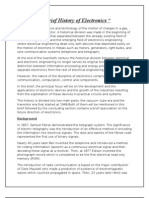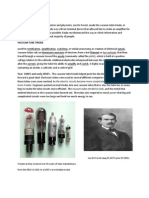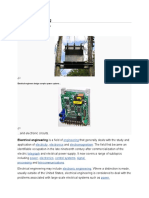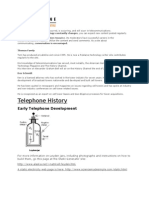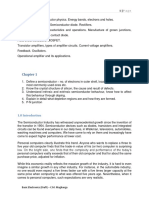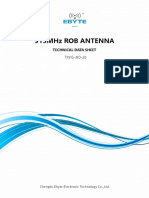Electronics
Electronics
Uploaded by
Rexi AbonCopyright:
Available Formats
Electronics
Electronics
Uploaded by
Rexi AbonOriginal Title
Copyright
Available Formats
Share this document
Did you find this document useful?
Is this content inappropriate?
Copyright:
Available Formats
Electronics
Electronics
Uploaded by
Rexi AbonCopyright:
Available Formats
Electronics is defined as the branch of science that deals with the flow and control of electrons.
It also
the study of effects, behavior and movement of electrons. Electronics deals with flow of charge
(electron) through non-metal conductors (semiconductors).
The history of electronics is a story of the late nineteenth and early twentieth centuries and of three key
components—the vacuum tube, the transistor, and the integrated circuit. In 1883, Thomas Alva
Edison discovered that electrons flow from one metal conductor to another through a vacuum. This
discovery of conduction became known as the Edison effect. In 1904, John Fleming applied the Edison
effect in inventing a two-element electron tube called a diode, and Lee De Forest followed in 1906 with
the three-element tube, the triode. The first applications of electron tubes were in radio
communications. Guglielmo Marconi pioneered the development of the wireless telegraph in 1896 and
long-distance radio communication in 1901. In 1918, Edwin Armstrong invented the “superheterodyne
receiver” that could select among radio signals or stations and could receive distant signals. Radio
broadcasting grew astronomically in the 1920s as a direct result. Armstrong also invented wide-band
frequency modulation (FM) in 1935; only AM or amplitude modulation had been used from 1920 to
1935. In 1947, a team of engineers from Bell Laboratories invented the transistor. John Bardeen, Walter
Brattain, and William Shockley received a Nobel Prize for their creation, but few could envision how
quickly and dramatically the transistor would change the world.The concept of the integrated circuit was
proposed in 1952 by Geoffrey W. A. Dummer, a British electronics expert with the Royal Radar
Establishment. Throughout the 1950s, transistors were mass produced on single wafers and cut
apart. By 1961, integrated circuits were in full production at a number of firms, and designs of
equipment changed rapidly and in several directions to adapt to the technology. All these radical
changes in all these components led to the introduction of microprocessors in 1969 by Intel. Soon after,
the analog integrated circuits were developed that introduced an operational amplifier for analog signal
processing.
Application of Electronics are Industrial Automation and Motion Control, Medical Applications and
Consumer Electronics , etc.
Everyday we are dealing with electronic circuits and other forms of electronic devices such as gadget,
TV, computers,cellphones and many others. Looking back to the past knowing the brief history of
electronics is necessary to revive our minds and to get inspired by the amazing inventions and
discoveries they made up.
Today's world of electronics has made significant gains in a variety of fields, including healthcare, medica
l diagnosis, autos, industries, electronics projects, and so on, convincing everyone that working without
electronics is virtually impossible.
https://www.vedantu.com/physics/electronics-in-daily-life
You might also like
- Leco CS-200Document394 pagesLeco CS-200Edariel Huaman Aquino100% (5)
- Reissue: MODELS 182, R182, 185, U206, 207, AND 210 SERIESDocument910 pagesReissue: MODELS 182, R182, 185, U206, 207, AND 210 SERIESPabloLamelaNo ratings yet
- A Brief History of Electronics Complete)Document8 pagesA Brief History of Electronics Complete)Maram AhmedNo ratings yet
- History of Electronics: TransistorDocument18 pagesHistory of Electronics: TransistorAngelo Zaldy FranciaNo ratings yet
- Reference Notes Introduction To Electrical EngineeringDocument8 pagesReference Notes Introduction To Electrical Engineeringokumuenock000No ratings yet
- Electronics DefinitionDocument12 pagesElectronics DefinitionSo NnyNo ratings yet
- History of Electronics and Their Generations in BreifDocument14 pagesHistory of Electronics and Their Generations in BreifHarshal VaidyaNo ratings yet
- Table of ContentDocument14 pagesTable of ContentmaderaclairolNo ratings yet
- ASSIGNMENTDocument5 pagesASSIGNMENTALJAN VALERANo ratings yet
- History of Electronics PDFDocument5 pagesHistory of Electronics PDFEj Mar ManabatNo ratings yet
- 1 Introduction To Industrial ElectronicsDocument29 pages1 Introduction To Industrial ElectronicsScribdTranslationsNo ratings yet
- Lesson 1 Intro To ElectronicsDocument8 pagesLesson 1 Intro To ElectronicsJas LmsnNo ratings yet
- Reporting Ee 1Document9 pagesReporting Ee 1josiephilmanzano12No ratings yet
- Semiconductor Devices Notes1Document23 pagesSemiconductor Devices Notes1Sivasai CharithaNo ratings yet
- A Brief History of ElectronicsDocument9 pagesA Brief History of ElectronicsImaduddin SharafiNo ratings yet
- Difference Between Transistor and Vacuum TubeDocument5 pagesDifference Between Transistor and Vacuum TubeBib YenNo ratings yet
- History of GSM - OutputDocument11 pagesHistory of GSM - OutputRaj MohanNo ratings yet
- A Brief History of Electronic: From Vacuum Tube To Solid StateDocument12 pagesA Brief History of Electronic: From Vacuum Tube To Solid StateHarkishen SinghNo ratings yet
- History of Electricity and ElectronicsDocument4 pagesHistory of Electricity and ElectronicsKorrene ReyesNo ratings yet
- ElectronicsDocument3 pagesElectronicsSherlyn MeranNo ratings yet
- ElecsDocument10 pagesElecsAdriel JohnNo ratings yet
- History of TransistorDocument4 pagesHistory of TransistorPerpekto D. MaculanganNo ratings yet
- Ece1: Electronics Devices and Circuits: HistoryDocument10 pagesEce1: Electronics Devices and Circuits: HistoryAdriel JohnNo ratings yet
- A Brief History of ElectronicsDocument12 pagesA Brief History of ElectronicsJayvee ColiaoNo ratings yet
- Famous Scientists and Inventors Who Shaped Electronics EngineeringDocument6 pagesFamous Scientists and Inventors Who Shaped Electronics EngineeringDekzie Flores Mimay100% (1)
- History of Wireless Communications1 - 2015-07-22Document4 pagesHistory of Wireless Communications1 - 2015-07-22salahberraNo ratings yet
- Evolution and Impact of ElectronicsDocument20 pagesEvolution and Impact of ElectronicsIlavarasan TamizhNo ratings yet
- Electronic Engineering - Julia AldredDocument117 pagesElectronic Engineering - Julia AldredParker333100% (1)
- 5Document1 page5Subhan AhmadNo ratings yet
- Electronics: The History of Electronics The Vacuum Tube EraDocument14 pagesElectronics: The History of Electronics The Vacuum Tube EraAliyaNo ratings yet
- History of Electronic Engineering - WikipediaDocument42 pagesHistory of Electronic Engineering - WikipediajoventuraNo ratings yet
- Selected Landmarks in ElectronicsDocument8 pagesSelected Landmarks in ElectronicsSatish K. RamojiNo ratings yet
- Transistor Concept.: Cell Phones ComputersDocument3 pagesTransistor Concept.: Cell Phones ComputersimtiazNo ratings yet
- 1.discovery of Electricity PresentationDocument12 pages1.discovery of Electricity PresentationangelitoNo ratings yet
- Electrons and Holes Put to Work in the Semiconductor ChipFrom EverandElectrons and Holes Put to Work in the Semiconductor ChipRating: 5 out of 5 stars5/5 (1)
- Bipolor Junction Transistor.: Cell Phones ComputersDocument3 pagesBipolor Junction Transistor.: Cell Phones ComputersimtiazNo ratings yet
- How and Why Transistor: Cell Phones ComputersDocument3 pagesHow and Why Transistor: Cell Phones ComputersimtiazNo ratings yet
- Explanation of TransistorDocument3 pagesExplanation of TransistorimtiazNo ratings yet
- History of ElectronicsDocument19 pagesHistory of ElectronicsElmarie RecorbaNo ratings yet
- IA 212 - Hand OutsDocument5 pagesIA 212 - Hand Outsfern suenoNo ratings yet
- Why Transistor: Cell Phones ComputersDocument3 pagesWhy Transistor: Cell Phones ComputersimtiazNo ratings yet
- History of Radio 1Document16 pagesHistory of Radio 1GODINEZ_LUISFE100% (1)
- ECE321-1A Assignment #1 06-23-11 Pg1-15Document15 pagesECE321-1A Assignment #1 06-23-11 Pg1-15RischienMarquezNo ratings yet
- Famous Scientists and InventorsDocument10 pagesFamous Scientists and InventorsRafael AclanNo ratings yet
- Famous Scientists and Inventors-Merged-CompressedDocument299 pagesFamous Scientists and Inventors-Merged-CompressedMaldives CanadaNo ratings yet
- Electrical EngineeringDocument10 pagesElectrical Engineeringkim jeonNo ratings yet
- Term Paper On Radio Submitted ToDocument24 pagesTerm Paper On Radio Submitted ToHabibur Rahman HridoyNo ratings yet
- Abstraction: How Electronics Devices Begin?Document11 pagesAbstraction: How Electronics Devices Begin?Shane Patrick PanilagNo ratings yet
- History of ElectronicsDocument5 pagesHistory of ElectronicsCat de la TorreNo ratings yet
- Introduction To Telecommunication Networks: 1.1 Historic Steps in The Telecommunication EraDocument65 pagesIntroduction To Telecommunication Networks: 1.1 Historic Steps in The Telecommunication EraZemenu BelieNo ratings yet
- InventorsDocument3 pagesInventorsGian albert mendaroNo ratings yet
- Electrical Engineering: From Wikipedia, The Free EncyclopediaDocument6 pagesElectrical Engineering: From Wikipedia, The Free EncyclopediaKaran KimianNo ratings yet
- The Story of Electronics and Artificial IntelligenceFrom EverandThe Story of Electronics and Artificial IntelligenceNo ratings yet
- TeliphoneDocument109 pagesTeliphonemodismm33100% (1)
- 第2次课Document16 pages第2次课tianle18118No ratings yet
- Brief History of ElectronicsDocument2 pagesBrief History of ElectronicsLaureenMiranda100% (1)
- Electronics History PDFDocument75 pagesElectronics History PDFYi Yi HlaingNo ratings yet
- To Study The Customer Satisfaction in AirtelDocument77 pagesTo Study The Customer Satisfaction in AirtelSami Zama0% (1)
- Basic Electronics Chapter 1 2Document29 pagesBasic Electronics Chapter 1 2victor kimutaiNo ratings yet
- Stochastic ProcessDocument17 pagesStochastic ProcessSoloproNo ratings yet
- Info Sheet - No. 1 - ElectronicsDocument23 pagesInfo Sheet - No. 1 - ElectronicsRai ZaNo ratings yet
- ENENSYS DTTCaster DatasheetDocument4 pagesENENSYS DTTCaster DatasheetaissamNo ratings yet
- V-Pol - Colinear - 360° - 3.0 DBD: Electrical CharacteristicsDocument1 pageV-Pol - Colinear - 360° - 3.0 DBD: Electrical CharacteristicsWesdi DNo ratings yet
- 01-Introduction To Power System Protection-EE466Document28 pages01-Introduction To Power System Protection-EE466Shoaib ShahriarNo ratings yet
- Phased ArrayDocument16 pagesPhased ArrayAzazelNo ratings yet
- Up 890 InstallationDocument6 pagesUp 890 InstallationAhmed GunaidNo ratings yet
- Physics Lab Manual - 2021-22Document38 pagesPhysics Lab Manual - 2021-22Aneesh KhandveNo ratings yet
- Pioneer Deh-P5080ub Crt4133 Car AudioDocument4 pagesPioneer Deh-P5080ub Crt4133 Car AudioTeles SilvaNo ratings yet
- Benchmark BSH5001-BSH5002 Instruction ManualDocument16 pagesBenchmark BSH5001-BSH5002 Instruction ManualMARIA ALEJANDRA SIERRA GILNo ratings yet
- Analog & Digital Communication (EC 1842)Document25 pagesAnalog & Digital Communication (EC 1842)Mayank ChoudharyNo ratings yet
- Manual de Serviço SLR5100Document178 pagesManual de Serviço SLR5100Giovany Toigo Colling100% (1)
- Icp103450ca V6 800578007680094Document1 pageIcp103450ca V6 800578007680094peter smithNo ratings yet
- Casio Module 3274Document3 pagesCasio Module 3274eddielindermannNo ratings yet
- Motor Bridge Controller: 1 Features Figure 1. PackageDocument17 pagesMotor Bridge Controller: 1 Features Figure 1. PackageNoelNo ratings yet
- EEE111 - Lab ManualDocument28 pagesEEE111 - Lab ManualAnindita MishiNo ratings yet
- Lc420wun Scd1 LGDocument37 pagesLc420wun Scd1 LGjoao jtecNo ratings yet
- Relee Termice TSA 2010Document6 pagesRelee Termice TSA 2010Alin PopNo ratings yet
- SE WP Arc Fault Protection in PV Systems ENDocument14 pagesSE WP Arc Fault Protection in PV Systems ENmatevzNo ratings yet
- 915Mhz Rob Antenna: Technical Data SheetDocument5 pages915Mhz Rob Antenna: Technical Data SheetyugenmyoNo ratings yet
- Training of TRANSFORMERDocument24 pagesTraining of TRANSFORMERSusanta royNo ratings yet
- Transformer Failure InvestigationDocument5 pagesTransformer Failure InvestigationVishal Mahire100% (2)
- CA751 IM E GeorgiaDocument56 pagesCA751 IM E GeorgiaGiorgi KurtsikidzeNo ratings yet
- 1N4001 Diode - 1: RS Flip-FlopDocument2 pages1N4001 Diode - 1: RS Flip-FlopSaliya De SilvaNo ratings yet
- Powerstak Pps2200101asDocument32 pagesPowerstak Pps2200101asjunyang liNo ratings yet
- AP60B Instructions1Document18 pagesAP60B Instructions1Jafar A BarakatNo ratings yet
- Wiring Manual: Supplement ContainsDocument108 pagesWiring Manual: Supplement ContainsАлександрNo ratings yet
- Split-Type Air Conditioners: Indoor UnitDocument22 pagesSplit-Type Air Conditioners: Indoor Uniteugenio103No ratings yet
- Chapter 2 ActuatorsDocument20 pagesChapter 2 ActuatorsMuhammad AniqNo ratings yet
- Valve Controller: Series ND800Document20 pagesValve Controller: Series ND800Nano SujaniNo ratings yet


